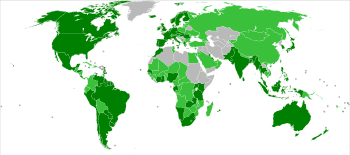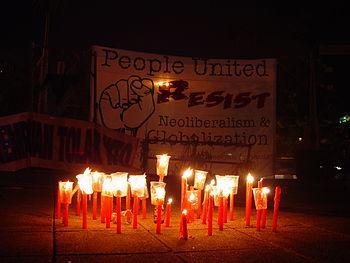
English: WTO founder members (1 January 1995) WTO subsequent members (Photo credit: Wikipedia)

Jakarta WTO protest2 (Photo credit: Wikipedia)
Globalization is the trend toward greater economic, cultural, political, and technological interdependence among national institutions and economies.
A. Globalization of Markets
- Convergence in buyer preferences in markets around the world
- Reduces marketing costs by standardizing activities
- Creates market opportunities abroad if home is small or saturated
- Levels uneven income streams for global seasonal products
- Yet companies must not overlook buyers’ needs
- Need for global sustainability—development that meets the needs of the present without compromising the ability of future generations to meet their own needs.
2. The world’s 7 billion people live in three types of markets, yet all require companies to act in a sustainable manner:
a. Developed markets are solidly middle class and people can consume almost any product desired. A firm may use the latest technologies to develop sustainable products in a sustainable manner.
b. Emerging markets are racing to catch up to rich nations and are overloading infrastructures. Resource constraints can force companies to develop sustainable production methods.
c. Traditional markets have mostly rural populations for whom poverty and corruption prevail. Here, sustainability means teaching safe farming practices, environmental stewardship, and disease awareness.
B. Globalization of Production
- Dispersal of production activities to locations that help a company to minimize costs or maximize quality
- Access lower-cost workers to cut overall production costs
- Access technical expertise
- Access production inputs unavailable or more costly at home
4. FORCES DRIVING GLOBALIZATION
Forces increase competition among nations by leveling the global business playing field.
A. Falling Barriers to Trade and Investment
1947 General Agreement on Tariffs and Trade (GATT) was designed to promote free trade by reducing tariffs and nontariff barriers. 1994 GATT revision (1) reduced tariffs and lowered subsidies for agricultural products; (2) defined and protected intellectual property rights; and (3) created the WTO.
1. World Trade Organization
a. World Trade Organization (WTO) is the international organization that enforces the rules of international trade.
b. WTO goals: (1) to help the free flow of trade, (2) help negotiate the further opening of markets, and (3) settle trade disputes.
c. WTO agreements are contracts committing members to fair and open trade policies. WTO dispute settlement system is the spine of the global trading system.
2. Regional Trade Agreements
a. Smaller groups of nations also are integrating their economies (e.g., NAFTA, European Union).
3. Trade and National Output
a. Effect of the WTO and regional trade pacts is greater global trade and cross-border investing (Map 1.1).
- Trade growth has been faster than world output.
- Gross Domestic Product (GDP) is the value of all goods and services produced by a domestic economy over a one-year period. Gross national product (GNP) adds income from international activities.
B. Technological Innovation
Technology accelerates globalization by making it easier, faster, and less costly to move data, goods, and equipment around the world.
- E-mail and Videoconferencing
a. Speed information flows and ease the tasks of coordination and control, which are complicated by operating across borders.
b. Driving growth in videoconferencing are lower-cost bandwidth and equipment, and decreased travel for cost or safety reasons.
- The Internet
a. Helps firms sharpen forecasting, lower inventories, improve communication with suppliers, and communicate quickly and cheaply with distant managers
b. Reduces the cost of reaching an international customer base, which is essential for the competitiveness of small firms
- Company Intranets and Extranets
a. Intranets are private networks of company Web sites and other information sources that allow employee access to information from distant locations.
b. Extranets are computer networks that give distributors and suppliers access to a company’s database so they can place orders or restock inventories electronically and automatically.
- Advancements in Transportation Technologies
a. Make global shipping more efficient and dependable (e.g., GPS)
- Measuring Globalization
1. The KOF Swiss Economic Institute’s Globalization Index ranks nations on their economic, social, and political engagement.
2. Richest nations are the most global, with many in Europe. The United States ranked 35th (see Table 1.1).
3. The least global nations are found in Africa, East Asia, South Asia, Latin America, and the Middle East. Low technological connectivity slows global integration.
5. UNTANGLING THE GLOBALIZATION DEBATE
People can view globalization from vastly different perspectives.
A. Today’s Globalization in Context
1. First age of globalization extended from the mid-1800s to the 1920s. Migration levels reached record highs, domestic workers faced competition from cheaper labor abroad, and trade and capital flowed more freely than ever before.
2. Drivers of that first age of globalization were the steamship, telegraph, railroad, telephone, and airplane.
3. World War I, the Russian Revolution, and the Great Depression abruptly ended that first age of globalization. A globalization backlash led to high tariffs and other barriers.
4. Geographic divide between East and West became an ideological divide between communism and capitalism. International capital flows regained their prior pace but not until the 1990s.
5. Drivers of this second age of globalization are communication satellites, fiber optics, microchips, and the Internet.
B. Introduction to the Debate
1. The World Bank is an agency created to provide financing for national economic development efforts.
2. The International Monetary Fund (IMF) is an agency created to regulate fixed exchange rates and enforce the rules of the international monetary system.
C. Globalization’s Impact on Jobs and Wages
- Against Globalization
a. Eliminates jobs in developed nations as good-paying manufacturing jobs go abroad to developing countries. Low-priced goods are not worth lost jobs.
- Lowers wages in developed nations by causing worker dislocation that gradually lowers wages. New jobs that replace lost manufacturing jobs often pay less.
- Exploits workers in developing nations who work cheaply servicing western consumers.
- Summary: Although globalization eliminates jobs in some economic sectors, it creates jobs in other sectors.
- For Globalization
a. Increases wealth and efficiency in all nations because trade openness raises output. Firms grow more efficient and pass savings on to consumers.
b. Generates labor market flexibility in developed nations that allows an economy to rapidly deploy labor where demand is relatively great.
c. Advances the economies of developing nations by injecting capital that creates higher-paying jobs, which expands the middle class and raises standards of living.
d. Summary: Gains to national economies are worth lost livelihoods that individuals may suffer.
D. Globalization’s Impact on Labor, the Environment, and Markets
1. Labor Standards
a. Trade unions claim that firms continually move to nations with low labor standards, which reduces labor’s bargaining power and forces overall labor standards lower.
b. But studies of developing nations’ export processing zones instead find evidence that contradicts such claims.
2. Environmental Protection
a. Globalization opponents say it creates a “race to the bottom” in environmental conditions and regulations: countries compete in reducing environmental protection laws.
b. But evidence shows pollution-intensive U.S. firms tend to invest in countries with stricter environmental standards. Also, closed economies historically are the worst polluters.
3. Future Markets
a. Protesters claim international firms pay locals the lowest possible wage and export their goods back to the home country.
b. Today, firms want to build local markets in developing nations, not simply exploit workers and foment local animosity.
E. Globalization and Income Inequality
1. Inequality within Nations
a. Globalization critics claim that income disparity in rich nations is increasing as firms move factory jobs to poor nations.
b. Evidence is mixed, but poor people in developing nations seem to benefit from an open economy.
2. Inequality between Nations
a. Globalization opponents say it is widening the gap in average incomes between rich and poor nations.
b. Looking closely at the evidence, we see that open nations are benefiting from trade whereas closed ones are not.
3. Global Inequality
a. Opponents of globalization say it is widening income inequality among all people of the world.
b. Studies tend to agree that global inequality has fallen in recent decades, though they disagree on the extent of the decline.
F. Globalization’s Influence on Cultures
1. Critics say globalization homogenizes our world and lets MNCs destroy cultural diversity and wipe out small local businesses.
2. Yet globalization allows nations to: (1) specialize and trade for goods they do not produce, (2) import other peoples’ cultural goods, and (3) still protect deeper moral and cultural norms.
G. Globalization and National Sovereignty
1. Globalization: Menace to Democracy?
a. Supranational institutions with international goals and appointed officials undermine national sovereignty and democracy.
b. Elected officials undercut democracy and local and regional authority with “international” agreements on citizens’ behalf.
2. Globalization: Guardian of Democracy?
a. Globalization has helped spread democracy worldwide (e.g., more democratic nations than ever).
b. Some losses of sovereignty have had positive social impacts, as in human rights, workers’ rights, and discrimination.
6. WHY INTERNATIONAL BUSINESS IS SPECIAL
What makes international business special is that it occurs within a dynamic, integrated system that weaves together four distinct elements.
A. The Global Business Environment
1. Globalization is transforming our societies and commercial activities. It also increases competition everywhere, forcing companies to be vigilant.
2. Each national business environment consists of unique cultural, political, legal, and economic characteristics. Companies must be attentive to nuances and adapt products and practices as needed.
3. The international business environment influences how business is conducted so firms must closely monitor events.
4. Context of international business management is defined by the characteristics of the national and international business environments. Managers must abide by the prevailing rules in each market in which it operates.
B. The Road Ahead for International Business
Part 1 (Chapter 1): Globalization
Part 2 (Chapters 2–4): National Business Environments
Parts 3 and 4 (Chapters 5–8 and 9–10): International Business Environment
Part 5 (Chapters 11–16): International Business Management
7. BOTTOM LINE FOR BUSINESS
A. Harnessing Globalization’s Benefits
1. The most global nations tend to have the greatest equality, robust environmental protection, inclusive political systems, lowest levels of corruption, healthiest lifestyles, and be where women have achieved the most social, educational, and economic progress.
2. The debate has opened a dialogue on how globalization can be harnessed to make its benefits exceed its costs.
B. Intensified Competition
1. Continued globalization is taking companies into previously isolated markets and increasing competitive pressures worldwide.
2. As it gets easier and less costly to manage widely dispersed marketing and production activities, new opportunities and threats emerge.
C. Wages and Jobs
1. Low wages are not all that draws investment by multinationals. A location must offer low-cost, adequately skilled workers in an environment with acceptable levels of social, political, and economic stability.
2. Labor mobility is increasing with globalization—depressing wages in some job categories but developing new job opportunities in others.
D. The Policy Agenda
1. Rich nations could open their markets, slash agricultural subsidies, and increase development aid. Poor nations could improve their investment climates and improve social protection for the poor.
2. Rich nations could offer workers their wage insurance, subsidized health insurance if out of work, and improve education. Rich nations could help enforce labor standards, help clarify environmental agreements, and research the environmental implications of trade agreements.

